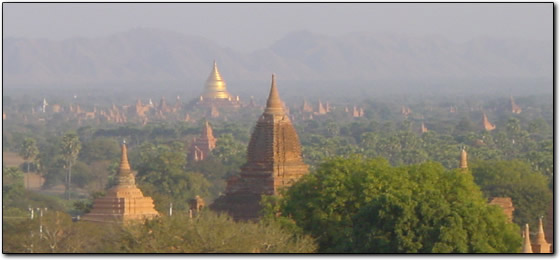
Bagan
Imagine if all of the cathedrals of Europe were constructed in one flat, dusty plain created by the bend of a meandering river. Thousands of brick “payu” were constructed over the centuries in the area around Bagan. Temples of every size and shape dot the flat plain nestled in the bend of the Ayeyarwady River. The area around Bagan lies in a dry zone. With dusty red sand and scrubby bushes and trees, it looks more like a desert than other parts of Myanmar. Map in hand, we rode dutifully through the area trying to visit the most interesting of the pagodas. Some were unique for their interior frescoes, other for their interesting shape or decoration. No two appeared alike, although many of the smaller, less important temples have been completely rebuilt from scratch. The government of Myanmar is known to “restore” the temples by building carbon-copies on the sites of earlier ruins. These brand new replacements, their red bricks not yet dulled to black by the passing of time, greeted us alone and in groups at every turn.
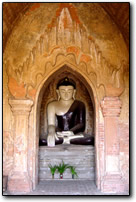 |
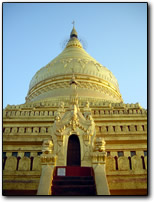 |
 |
Bagan is also famous for lacquerware. We wandered into one village and poked our noses into a compound where bowls were being made. To make small bowls, the black, gooey tar is painted repeatedly on a form made from a coil of bamboo. Once the bowls have been given enough layers and are thoroughly dry, decorations will be scraped into the surface and then dusted with color. With a little shopping, we found a place selling good-quality lacquer and bought a few souvenirs.
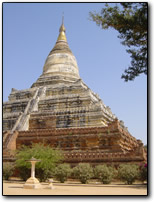 |
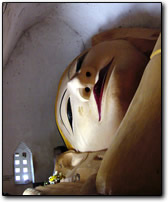 |
Before catching a bus back to Yangon, we visited nearby Mount Popa. Nearby Taung Kalat, a freestanding plug of basalt, is crowned with an important shrine for “Nats”, or Burmese nature spirits. Despite having been banned by earlier, purist Buddhist ruling elements, the Nats eventually made a comeback. Nat shrines coexist in most Burmese holy places and are often found below giant banyan trees. As we made our way up to the summit of temple, revered as the dwelling place of the Nats, pesky monkeys leapt and begged on the stairs. From the top we could clearly see the conical summit of Mount Popa, an extinct volcano, its sides still covered with thick forest.
 |
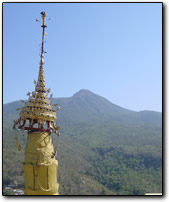 |
Passing through a village as we made our way down, we passed a kind of “pwe” or festival in one of the houses. A man a tightly wrapped, brightly-colored sarong, his face made up with white paint and red lipstick, sang over a cacophonous medley of drums, cymbals and gongs. Part M.C., part spirit channel, he swayed drunkenly as he downed a glass of liquor during a musical interlude, then, gesticulating to the deafening music, belted a wailing cry into the microphone as a final flourish. In the open room the audience, what appeared to be an extended family, applauded and slowly rose to mill about. We continued on our way.
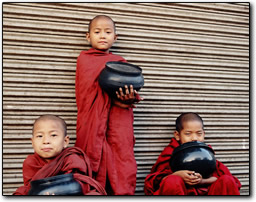 |
